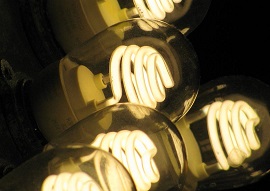Energy in the built environment
[edit] Introduction
In very general terms, energy is a capacity to do work that can take a number of different forms, such as; thermal (heat), radiant (light), motion (kinetic), stored (potential), secondary (e.g. electricity), chemical, mechanical, and so on.
In the built environment, the term 'energy' is typically used in the context of generating heat, powering equipment, creating products and materials, transportation, and so on.
Sources of energy tend to be categorised as either renewable or non-renewable.
The main types of renewable energy sources include:
- Solar thermal energy: The conversion of solar radiation to thermal energy in order to heat a working fluid.
- Geothermal energy: The natural heat energy stored in the earth.
- Wind energy: Energy generated by the wind.
- Biomass: A generic term referring to organic materials that can be used as fuels.
- Hydropower: The generation of electricity from flowing water power.
For more information, see Renewable energy.
The main types of non-renewable energy include:
- Petroleum products: Formed from dead plants and animals. E.g. petrol, diesel, kerosene.
- Hydrocarbon gas liquids: Such as liquefied petroleum gas (LPG).
- Natural gas: Distributed through pipes from point of origin to point of use, e.g. mains gas.
- Coal: A combustible material mined from the ground.
- Nuclear energy: Released during nuclear fission or fusion in a power plant.
For more information, see Types of fuel.
Energy can be stored to try and off-set the risks of more unpredictable and intermittent power generation or availability. For more information, see Energy storage.
According to the Technology Strategy Board, in the UK, the built environment accounts for 45% of total carbon emissions (27% from domestic buildings and 18% from non-domestic), and 73% of domestic emissions arise from space heating and the provision of hot water. The EU Directive on the energy performance of buildings was adopted in 2002. It was intended to improve the energy efficiency of buildings, reduce carbon emissions and reduce the impact of climate change.
Energy performance certificates (EPCs), set out the energy efficiency rating of buildings. They are required when buildings are built, sold or rented if they have a roof and walls and use energy to condition an indoor climate. Buildings are rated from A to G on EPCs, with A representing a very efficient building and G a very inefficient building.
For more information, see Energy performance certificate.
The term 'embodied energy' relates to the energy consumed to create a building or a component of it, the energy consumed in refurbishing and maintaining it during its life, and the energy consumed in its ultimate disposal.
For more information see: Embodied energy.
[edit] Articles about energy
Designing Buildings has a number of articles relating to energy, including:
- Battery storage.
- Biogas.
- Biomass.
- CHP.
- Community energy network.
- CRC Energy Efficiency Scheme.
- Domestic micro-generation.
- Dynamic response to energy.
- Electricity supply.
- Embodied energy.
- Emission rates.
- Energy Act.
- Energy consumption.
- Energy content.
- Energy harvesting.
- Energy hierarchy.
- Energy certificates.
- Energy related products regulations.
- Energy Savings Opportunity Scheme.
- Energy security.
- Energy storage.
- Energy storage - the missing piece?
- Energy targets.
- Fuel cell.
- Ground energy options.
- Hydroelectricity.
- Potential energy.
- Plasma energy.
- Process energy.
- Renewable energy.
- Solar photovoltaics
- Solar thermal systems.
- Target emission rate TER.
- The Future of Electricity in Domestic Buildings
- Tidal lagoon power.
- Types of fuel.
- Useful energy.
- Utilities.
- Watt.
- Wind Energy in the United Kingdom.
[edit] Related articles on Designing Buildings
- BSRIA publishes Illustrated Guide to Renewable Technologies.
- Climate change science.
- Earth overshoot day.
- Electricity.
- Entropy.
- Environmental legislation.
- Fossil fuel.
- Green building.
- Intergovernmental Panel on Climate Change.
- Kinetic energy.
- Plasma energy.
- Plug load control.
- Power.
- Sustainability.
- The Carbon Plan: Delivering our low carbon future.
- Will we burn fossil fuels to power wind turbines in the future?
Featured articles and news
A change to adoptive architecture
Effects of global weather warming on architectural detailing, material choice and human interaction.
How big is the problem and what can we do to mitigate the effects?
Overheating guidance and tools for building designers
A number of cool guides to help with the heat.
The UK's Modern Industrial Strategy: A 10 year plan
Previous consultation criticism, current key elements and general support with some persisting reservations.
Building Safety Regulator reforms
New roles, new staff and a new fast track service pave the way for a single construction regulator.
Architectural Technologist CPDs and Communications
CIAT CPD… and how you can do it!
Cooling centres and cool spaces
Managing extreme heat in cities by directing the public to places for heat stress relief and water sources.
Winter gardens: A brief history and warm variations
Extending the season with glass in different forms and terms.
Restoring Great Yarmouth's Winter Gardens
Transforming one of the least sustainable constructions imaginable.
Construction Skills Mission Board launch sector drive
Newly formed government and industry collaboration set strategy for recruiting an additional 100,000 construction workers a year.
New Architects Code comes into effect in September 2025
ARB Architects Code of Conduct and Practice available with ongoing consultation regarding guidance.
Welsh Skills Body (Medr) launches ambitious plan
The new skills body brings together funding and regulation of tertiary education and research for the devolved nation.
Paul Gandy FCIOB announced as next CIOB President
Former Tilbury Douglas CEO takes helm.
UK Infrastructure: A 10 Year Strategy. In brief with reactions
With the National Infrastructure and Service Transformation Authority (NISTA).
Ebenezer Howard: inventor of the garden city. Book review.
Airtightness Topic Guide BSRIA TG 27/2025
Explaining the basics of airtightness, what it is, why it's important, when it's required and how it's carried out.






















